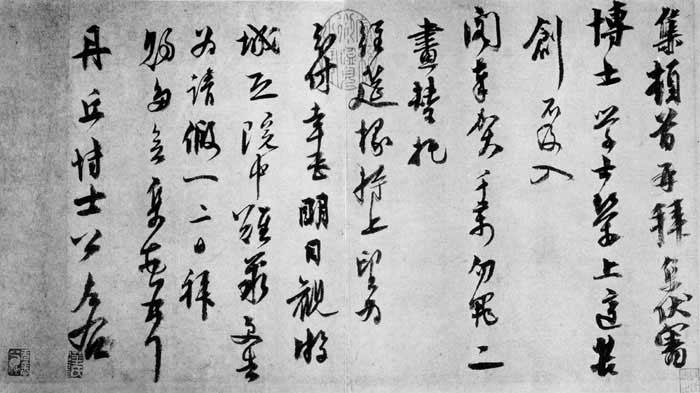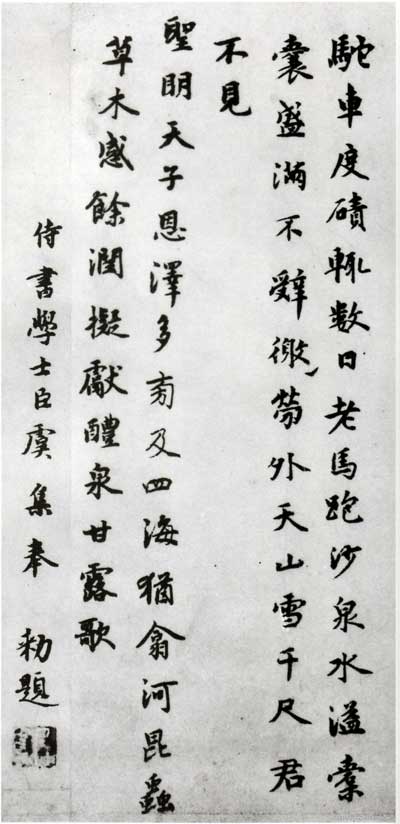Yu Ji (1272-1348) was a writer of the Yuan Dynasty. His courtesy name is Bosheng, his nickname is Daoyuan, and he is known as Mr. Shao'an. His ancestral home is Renshou (now part of Sichuan). His fifth generation ancestor, Yu Yunwen, was a famous patriotic general in the Southern Song Dynasty. He defeated the Jin army in the quarrying battle in Shaoxing in 1161, and he rose to the rank of prime minister. His father, Yu Ji, once served as a captain in Huanggang. After the death of the Song Dynasty, he lived in Chongren, Linchuan (now part of Jiangxi). Yu Ji studied Cheng-Zhu Neo-Confucianism since he was a child, and was deeply influenced by the orthodox ideas of Confucianism, but he was not rigidly bound to established laws and was relatively open-minded. After the death of the Song Dynasty, he lived in Chongren, Linchuan (now part of Jiangxi). In the first year of Dade of Emperor Chengzong of the Yuan Dynasty (1297), Yu Ji came to Dadu, and he was recommended as a professor of Confucianism in Dadu Road. During the reign of Renzong, he compiled it for Jixian. During the reign of Emperor Taiding, he was promoted to the rank of bachelor of the Hanlin Academy and concurrently of the Imperial Academy. When Wenzong was King Huai, he knew the name of Yu Ji. After he succeeded to the throne, he was awarded the bachelor's degree of Kuizhang Pavilion and the bachelor's degree of the Imperial Academy. He compiled the "Classic of Classics" with Zhao Shiyan and others. Because Yu Ji had issued an edict stating that Emperor Shun was not the eldest son of the Ming Dynasty, he excused himself from illness and returned home after Emperor Shun ascended the throne. His posthumous title is Wenjing.
The poems and essays were written by everyone at that time. "For a time, they were the official records of the ancestral temple and the court, and the tablets and tablets of the officials and officials came from his own hands. They became the words of the whole family." He is as famous as Yang Zai, Fan □ (Muheng), and Jiexisi, and is known as "Yu, Yang, Fan, and Jie", and is also known as the "Four Great Masters of Yuan Poetry". He advocated the tradition of Tang Dynasty and Zonggu, taking Li Bai and Du Fu as the authentic ones. He especially admired Tao Yuanming, Wang Wei, Wei Yingwu, Liu Zongyuan and others, and advocated an aesthetic view of "sleep, slowness and indifference". The style of poetry is rigorous, but mostly imitated by predecessors. There are "Ancient Records of Daoyuan Studies" and "Manuscripts of Daoyuan Studies".
He is also a master of calligraphy. He once worked with Zhao Mengfu in the Hanlin Academy, and Zhao Mengfu was his superior. His calligraphy was naturally influenced by Zhao Mengfu. Looking at his works, we can see that he has the charm of Jin people, and his clear and subtle spirit is not diminished by Zhao's. Tao Zong's "Calligraphy and History Meeting" said that he "all has legal standards for the true practice of cursive and seal writing. The ancient official script is the best in the contemporary era." Li Dongyang, a calligrapher of the Ming Dynasty, said: "There is a stream of calligraphers. The so-called people with high moral character and learning from the ancients are Bo Both living and dying." The writings are mainly left in the appreciation inscriptions and postscripts. The handed down works also include the ink version of "Liu Gai Shinto Stele Inscription" (collected by the Shanghai Museum). It is a real book with large characters. It can be seen that Zhong Yao and Su Shi's calligraphy was used as two seal seals of Kuizhang Pavilion. Fang "Kui Zhang Pavilion Treasure" and "Celestial Calendar Treasure" show that his seal script was also outstanding at that time. Although he was an important calligrapher at that time, his works were not widely circulated and his style was not very distinctive.

Not as good as the entry ticket, 21cmX37.7cm, collected by the National Palace Museum, Taipei

Painted poem titled "Picture of Jishui Fan Tribe" by Hu Qian, length 40.9cm
Collection of the National Palace Museum, Taipei








